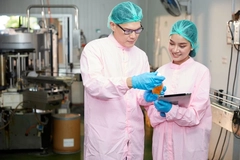Bionov Creates Innovation to Fight Cellulite

Cellulight takes its benefits from melon fruit (Cucumis melo L.) and especially from the high superoxide dismutase (SOD) content of Bionov exclusive and proprietary variety, from which it is obtained. For the first time, a 100% natural and vegetal ingredient is introduced on the market with clinically demonstrated effects against cellulite by oral route.
16 Oct 2012 --- Bionov will present its innovation of the year at Health Ingredients 2012 Frankfurt. CELLULIGHT, a new 100% natural active ingredient designed to fight cellulite – a women universal issue – thanks to a nonexistent mechanism of action on the market. Its strong scientific support added to its completely original positioning already allowed to this ingredient to be selected among more than 40 dossiers by the NuW Excellence Awards jury, in the Beauty Innovation of the year category.
Cellulight takes its benefits from melon fruit (Cucumis melo L.) and especially from the high superoxide dismutase (SOD) content of Bionov exclusive and proprietary variety, from which it is obtained. For the first time, a 100% natural and vegetal ingredient is introduced on the market with clinically demonstrated effects against cellulite by oral route.
Cellulight effect on cellulite has been evaluated in a double-blind, randomized placebo controlled clinical trial. 41 women with cellulite were supplemented with 40 mg daily during 56 days.
The findings reveal that Cellulight is able to significantly reduce fat nodes on thighs by 9.5% after only 28 days of supplementation, compared to the placebo group (* p<0.05). This effect reaches 11.3% at D56 (* p<0.05). Results are illustrated in the opposite figure.
Cellulight induces a significant visual decrease in fat nodes on thighs. This improvement was observed in 71% of subjects on D28 and 67% on D56.
“Cellulight is born from 2 years of research and is based on the hundreds scientific publications documenting the anti-fibrotic effect of SOD” comments Dr Lacan, R&D Director of Bionov. “This clinical study brings to light the clear application of this way of action: the anti-cellulite potential of Cellulight”, she adds.
Bionov also investigated complementary studies on the second main cause responsible for cellulite: adipocytes hypertrophy. Results show that Cellulight significantly increases lipolysis by 94% in treated adipocytes of women with cellulite, compared to control, as well as a significant reduction of adipocytes size.
Cellulite is a topographic skin change that affects 85-98% of postpubertal women, which represents more than 200 Million women concerned just in Europe and 2 Billion worldwide. In spite of an anti-cellulite cosmetic market of more than 3 billion US dollars, only few products exist by oral route. Furthermore, none of these existing products combat the first cause of cellulite, i.e. the fibrotic state located in the hypoderm and responsible for the fat nodes appearance.
“With Cellulight, Bionov permits to its customers to communicate on a completely original and nonexistent on the market mechanism of action”, analyzes Benoit Lemaire, Business & Marketing Director of Bionov. “More than a natural active ingredient, Cellulight is the first solution with orally clinical efficacy on cellulite for innovative positioning in weight management. This position has already been recognized to be among the Beauty Innovation of the year by the NuW Excellence Awards 2012 jury”, he concludes.
Cellulite is a common term used to describe a localized metabolic disorder of subcutaneous tissue that provokes an alteration in the female body shape. It presents as a modification of skin topography evident by skin dimpling and nodularity. It appears in 85-98% of post-pubertal women and is rarely seen in men. Common but not exclusive areas where cellulite is found are the thighs, buttocks, and to a lesser extent the abdomen. Contrary to popular belief, cellulite is not related to obesity, since it occurs in overweight, normal, and thin women. Fat cells hypertrophy combined with connective tissue fibrous state in the hypodermis are the two main scientifically recognized hypotheses explaining the physiology of cellulite.
While not a pathologic condition, it remains an issue of esthetic concern to a great number of individuals.












